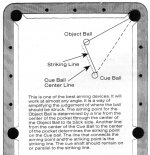.......
The biggest flaw with the system you described is that the harder to visualize the shot the worse this system is. Which is the opposite of useful.
This is so true. Plus it's not accuarte. Even it were accurate, any system that isn't easy to visualize is surely not going to be easy to implement. Of course, after several thousand shots you'll think you're visualizing the system better, but your success will be due to rote, hours upon hours of trial and error, not the system itself.
Last edited:

![CropperCapture[125].jpg CropperCapture[125].jpg](https://forums.azbilliards.com/data/attachments/414/414614-c69545879336280b53d97908bf7c5cf1.jpg)